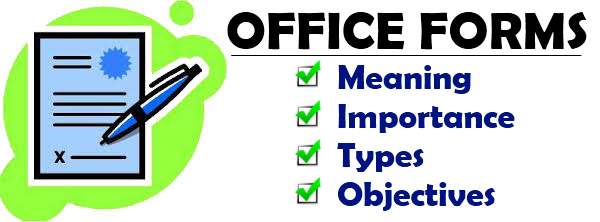Office Forms | Meaning | Importance | Types | Objectives

Table of Contents
Introduction to Office Forms
The required data were collected and brought together for office use with the help of office forms. The collected data have been processed and supplied in a systematic way. Generally, the date may be collected from outside the office at the maximum, say, bills, quotations, orders, statistical data, return etc.
The ready-made forms help the employees to collect the data without much difficulty. It means that clerical work is reduced and collects only required information briefly instead of writing down the whole matter. Hence, the form is printed or cyclostyled for future use. Forms may be filled in ink or with a typewriter.
Meaning of Office Form
A form is printed or cyclostyled piece of paper containing some information with blanks spaces left for the entry of required information briefly by the persons using it.
Definition of Office Form
J.C.Denyer,
“Printed piece of paper or card on which entries are usually made against marked headings”.
Office form may be defined as a vehicle by which the required information is collected briefly for the effective and economical function of an office.
Importance of Office Forms
An office can work very easily and economically with the help of receiving information through form. Time required to perform a work is reduced and the energy of the employee is saved. Therefore, the applications of printed forms have become an essential part of the office procedure.
Types of Office forms
Forms can be classified based on their utilization. They are
- purchase forms
- sales forms
- accounting forms and
- correspondence forms.
Then, the forms can be classified based on the number of copies required. They are
1. Single copy forms: Single copy form is used to save the only one purpose and kept by the anyone of the office employee.
2. Multiple copy forms: Multiple copy forms are prepared in more than two copies but according to the requirements. For example, if three copies are prepared; three employees in various departments or in various sections keep them.
Again, office forms are classified based on place of utilization. They are
1. Outside contact forms: Outside contact forms means forms used for collection of information from the outside of office. They are purchase orders, sales invoices, vouchers and the like.
2. Internal office forms: Internal office forms mean forms used for collection of information within the organization. They are requisitions, report forms, accounting forms and the like.
Objects or Purpose of Office Forms
1. Only the required information is alone received and supplied. Thus irrelevant and unnecessary are eliminated.
2. No piece of information is held up and misrepresented.
3. More clerical work is saved.
4. More information is supplied quickly in a meaningful way.
5. The collection of information is very easily done.
6. There is a possibility of increasing clerical efficiency and output.
7. Quick and clear understanding of information is possible.
